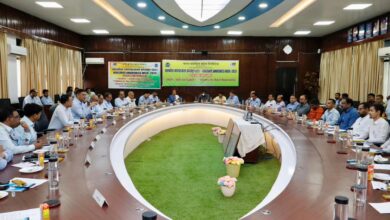India Reinforces Commitment to Energy Security and Exploration Growth: Hardeep Singh Puri
India Accelerates Scientific Exploration: 76% of Active E&P Area Opened Since 2014, 28 Blocks Awarded Under OALP Round-IX

“The Indian hydrocarbon sector is entering a new era of accelerated exploration and development,” said Hardeep Singh Puri, Minister of Petroleum and Natural Gas, while addressing the Open Acreage Licensing Policy (OALP) Round-IX and Special Discovered Small Field (DSF) Signing Ceremony held here tonight. He highlighted that through investor-friendly reforms, swift approvals, scientific exploration, and a strong emphasis on sustainability, India is steadily building a resilient and future-ready energy ecosystem aligned with the vision of Viksit Bharat.
Addressing the esteemed gathering of dignitaries, industry stakeholders, and investors, Shri Puri noted that today’s signing ceremony signifies much more than the completion of a procedural formality—it is a powerful testament to India’s unwavering commitment to reducing its import dependence and securing its energy future.
With India currently reliant on imports for 88% of its crude oil and 50% of its natural gas needs, the urgency for domestic exploration and production has never been greater. As the Minister pointed out, “In the next two decades, 25% of the world’s incremental energy demand growth will come from India.”
Reflecting on the past, Puri acknowledged the challenges the Indian upstream sector faced between 2006 and 2016—a “dull decade” marred by policy paralysis and procedural delays, leading to the exit of global energy giants like BP, ENI, and Santos. However, the tide has turned. “We were determined to unlock India’s untapped energy potential, estimated at approximately 42 billion tonnes of oil and oil equivalent of gas,” he said.
To that end, the Government has implemented a series of transformative reforms over the past decade. A key achievement has been the expansion of exploration activity, with the explored area of India’s sedimentary basins increasing from 6% in 2014 to 10% today, with a target of reaching 15%. The Minister reiterated the commitment to increasing exploration acreage to 1 million sq. km by 2030, highlighting the dramatic 99% reduction in “No-Go” areas within India’s Exclusive Economic Zone (EEZ).
Scientific, data-driven exploration has been a cornerstone of this strategy, backed by a ₹7,500 crore investment into new seismic data acquisition, aerial surveys in remote terrains, and stratigraphic wells. Importantly, geo-scientific data is now available for major basins on both coasts, with the National Data Repository being upgraded to a cloud-based platform to ensure faster, transparent access to seismic, production, and well data.
The Minister proudly noted that 76% of the total area currently under exploration has been brought under active exploration only since 2014. Under OALP Round-IX alone, 28 blocks across eight sedimentary basins have been awarded, covering 1.36 lakh square kilometers—38% of which fall in areas previously designated as “No-Go.” Additionally, two blocks were awarded under the Special DSF Round, with a total of 60 bids received.
“Congratulations to all the awardees. Your success will play a pivotal role in meeting our increasing energy demands as India continues its ascent as one of the world’s largest energy consumers,” Puri said.
Looking ahead, the Minister announced that OALP Round-X has already been launched at the India Energy Week 2025, offering 25 blocks across 13 sedimentary basins—covering the largest-ever acreage of 1.92 lakh square kilometers, with 51% falling in previously restricted zones.
Furthermore, DSF Round-IV is being launched tonight, comprising 55 discoveries across nine contract areas with estimated reserves of 258.59 million metric tonnes of oil equivalent (MMTOE). All blocks have undergone rigorous technical vetting by global experts, and critically, all relevant data is being made freely available to potential investors.

He also shared that under previous DSF Bid Rounds (I, II, and III), a total of 85 Revenue Sharing Contracts covering 175 fields have been awarded.
Highlighting the potential in unconventional hydrocarbon sources, Puri elaborated on India’s Coal Bed Methane (CBM) assets, currently estimated at 2,600 BCM. With 15 active CBM blocks—five already under production—the Government is preparing to launch a Special CBM 2025 Round to offer three new blocks (two in West Bengal and one in Gujarat), further diversifying India’s energy portfolio.
In a major legislative update, the Minister announced that the amended Oilfields (Regulation and Development) Act, 1948 (ORDA), will come into effect in April 15, 2025. This “landmark reform” modernizes India’s upstream regulatory framework and aligns it with international best practices.
The Government has also been responsive to industry concerns through the establishment of a Joint Working Group (JWG) comprising private E&P operators, National Oil Companies, the Ministry of Petroleum and Natural Gas, and the Directorate General of Hydrocarbons. “The JWG has submitted its report, and we are formally launching it this evening,” Puri announced.
In a move towards inclusive governance and legal clarity, the Minister also launched the draft PNG Rules Public Consultation Portal, encouraging industry and public stakeholders to share feedback. These rules will help shape future Model Revenue Sharing Contracts and streamline sectoral regulations.




